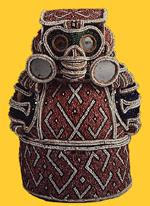 Jeannie Karayani Calcano (Taíno) connecting to her roots by making pasteles.
Jeannie Karayani Calcano (Taíno) connecting to her roots by making pasteles.Photo courtesy of Bohio de Atabey
by Roberto Múkaro Borrero
With the holiday season upon us, families across the Caribbean and the Diaspora will soon be serving up all manner of traditional meals. On the island of Borikén (Puerto Rico ), for example, no traditional holiday feast would be complete without a particular savory dish of indigenous Taíno origin known today as pasteles or "pasteles de hoja."
It should be understood from the outset that no matter what alterations they have undergone over the years, pasteles de hoja are indeed of indigenous origin. In fact, the elder relative of Caribbean pasteles is the “Mexican” corn tamale or tamalli in the indigenous Nahuatl language. The tamalli can be traced back as early as 5000 BC.
 Pasteles, like other tamalli-like foods, consist of boiled or steam-cooked “masa” (dough) with or without a filling. Pasteles can be filled with meats, vegetables or really any preparation according to taste. Today, the masa is most commonly wrapped in plantain leaves and parchment paper before cooking.
Pasteles, like other tamalli-like foods, consist of boiled or steam-cooked “masa” (dough) with or without a filling. Pasteles can be filled with meats, vegetables or really any preparation according to taste. Today, the masa is most commonly wrapped in plantain leaves and parchment paper before cooking.Making pasteles is a family affair. It has always been a time to strengthen family ties, renew friendships, and share life lessons with the younger generations. There is a lot of work that goes into making pasteles. For example, one family member might be tasked with guayando (grating) the iuka (yuca) or guineo (plantain), while another will prepare the masa or perhaps be in charge of trimming the plantain leaves. Someone else might have taken on seasoning the meat to perfection, while another can literally wrap the whole process up nicely.
As I understand it, in Boriken there were at least three and possibly more original “pasteles.” One original pastel was made from maisi (corn), one from iuka, and the other from the iautía (yautía). The term iautía refers to the plant Xanthosoma sagittifolium, not malanga (taro) as sometimes claimed. If you thought you were the only Boricuas making pasteles from iuka, surprise my sisters and brothers, our Taíno ancestors were preparing this earthy, culinary delight for generations.
In fact, Mais(i), iuka, and yautia are Taino words. The Taíno word for pasteles is taiuio (tayuyo) with some type of filling, meat or vegetable or both. The Taino word for another type of pastel, made from corn without any filling is called guanime. The term taiuio is still used today in parts of Cuba and the Dominican Republic.
So while your family is enjoying what I refer to as an original Taíno comfort food, please keep in mind that by eating pasteles you are actually continuing an indigenous tradition thousands of years in the making.
If seen in this light, sayings like “you are what you eat” may take on a whole new meaning.
Roberto Borrero is on staff at the American Museum of Natural History in its Department of Education. He also serves as Chairman of the NGO Committee on the United Nations International Decade of the World’s Indigenous Peoples and President of the Office of International Relations and Regional Coordination for United Confederation of Taino People
*An earlier version of this article originally appeared in La Diva Latina Magazine










No comments:
Post a Comment